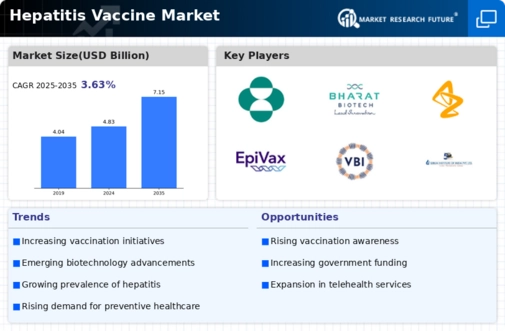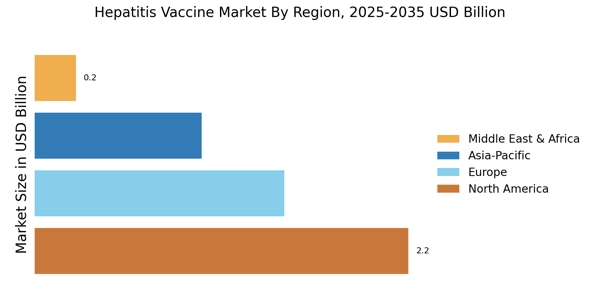Government Policies and Funding
Government policies and funding play a pivotal role in shaping the Hepatitis Vaccine Market. Many countries have implemented national immunization programs aimed at eradicating hepatitis infections. These initiatives often include financial support for vaccine development and distribution, which can significantly enhance market growth. For instance, funding from governmental and non-governmental organizations has been directed towards research and development of new vaccines, as well as public awareness campaigns. The commitment to achieving vaccination targets, such as those outlined in the Sustainable Development Goals, further underscores the importance of government involvement. As a result, the Hepatitis Vaccine Market is likely to benefit from increased investments and strategic partnerships that facilitate vaccine accessibility and affordability.
Rising Global Travel and Migration
Rising The Hepatitis Vaccine Industry. As individuals travel across borders, the risk of hepatitis transmission increases, particularly in regions with high prevalence rates. This trend has prompted health authorities to recommend vaccinations for travelers, thereby driving demand for hepatitis vaccines. Additionally, the movement of populations due to work or resettlement often leads to increased exposure to hepatitis viruses. Consequently, vaccination programs targeting travelers and migrants are becoming more prevalent. The need for pre-travel vaccinations and post-arrival health screenings is likely to bolster the Hepatitis Vaccine Market, as public health initiatives adapt to the challenges posed by increased mobility.
Increased Public Awareness and Education
Increased public awareness and education regarding hepatitis and its prevention are vital drivers for the Hepatitis Vaccine Market. Campaigns aimed at educating the public about the risks associated with hepatitis infections have led to a greater understanding of the importance of vaccination. Health organizations and advocacy groups are actively promoting hepatitis vaccination as a key preventive measure. This heightened awareness is reflected in rising vaccination rates in various demographics, particularly among high-risk populations. As individuals become more informed about the benefits of vaccination, the demand for hepatitis vaccines is likely to surge. Consequently, the Hepatitis Vaccine Market stands to gain from ongoing educational efforts that empower communities to prioritize their health.
Growing Incidence of Hepatitis Infections
The rising incidence of hepatitis infections is a critical driver for the Hepatitis Vaccine Market. According to health organizations, millions of new cases of hepatitis A, B, and C are reported annually, leading to increased morbidity and mortality rates. This alarming trend necessitates the urgent need for effective vaccination programs. The World Health Organization has indicated that hepatitis B and C infections alone account for a significant percentage of liver disease cases worldwide. Consequently, healthcare systems are prioritizing vaccination as a preventive measure, thereby propelling the demand for hepatitis vaccines. As awareness of the health risks associated with hepatitis grows, the Hepatitis Vaccine Market is likely to experience substantial growth, driven by both public health initiatives and individual healthcare choices.
Technological Innovations in Vaccine Production
Technological innovations in vaccine production are transforming the Hepatitis Vaccine Market. Advances in biotechnology, such as recombinant DNA technology and mRNA vaccine platforms, have led to the development of more effective and safer vaccines. These innovations not only enhance the efficacy of hepatitis vaccines but also streamline the production process, making it more cost-effective. For example, the introduction of novel adjuvants has improved immune responses, potentially increasing vaccination rates. Furthermore, the ability to rapidly produce vaccines in response to emerging hepatitis strains is crucial for public health. As these technologies continue to evolve, the Hepatitis Vaccine Market is expected to expand, driven by the demand for innovative solutions to combat hepatitis infections.


















Leave a Comment